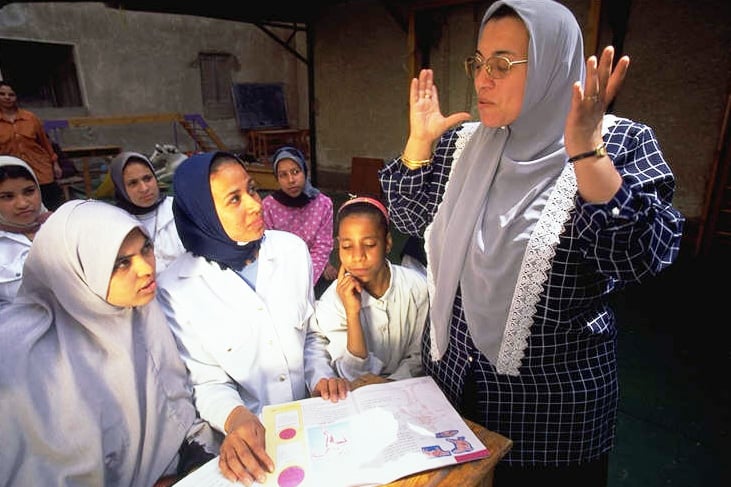“In all previous reports we thought there was no HIV data from this region. But there turned out to be lots of data here,” said Laith Abu Raddad, director of the Biostatistics and Biomathematic Research Core at Weill Cornell Medical College in Qatar and the principal author of the study (not yet available online).
“This report is basically more like a scientific epidemiological study: Getting pieces of data, thousands of data that we managed to collect from every country in the region, putting them together and analysing them to see what they tell us in terms of HIV epidemiology,” he said.
The report, characterizing the HIV/AIDS epidemic in the Middle East and North Africa, is a joint effort of the World Bank, the UN Joint Programme on HIV/AIDS (UNAIDS) and the World Health Organization (WHO). It covers 23 countries that the three organizations include in their MENA (Middle East and North Africa) region.
| Read more |
The report divides the MENA region into two categories according to HIV prevalence: the “subregion with considerable prevalence” (Djibouti, Somalia, Southern Sudan); and the Core MENA region, where HIV prevalence is described as “very limited” (the rest of MENA countries).
Sudan, Somalia and Djibouti
“In north Sudan, we used to think in the past that we have a much more serious problem of HIV but now the data set is more complete, it’s clear that north Sudan really is quite similar to the rest of the MENA countries. But in south Sudan we may have a generalized epidemic,” Abu Raddad said. A generalized epidemic is one that has spread beyond high-risk minority populations to the general population.
A 2003 UNAIDS and WHO report referred to in the study said Sudan had a 2.6 percent HIV prevalence rate.
Abu Raddad said Djibouti “was the Disneyland of risk behaviour” and had a large number of Ethiopian sex workers serving truck drivers and foreign army bases. “We have this corridor which is certainly full of HIV, but the rest of the country is fine,” he noted.
A 2008 UNAIDS report said Djibouti had a 3.4 percent HIV prevalence rate in its capital and a 1.1 percent rate outside it.
“Technically speaking, the HIV epidemics in Djibouti and Somalia are already generalized, but the context of HIV infection and risk groups in these countries suggests that HIV dynamics are mainly focused around concentrated epidemics in the commercial sex networks,” said the new report.
Pakistan, Afghanistan and Iran
|
Photo: Pakistan Society  |
| Pakistan faces a concentrated HIV epidemic among injecting drug users |
“We know we have a concentrated epidemic among IDUs in Pakistan, and the increase was very rapid over the past few years. In Karachi, for example, we had near zero percent among this group in 2003 or 2004 and then within six months it jumped to 24 percent.”
He said this increase could be attributed to needle sharing, poverty and a lack of awareness.
Egypt and Tunisia
Egypt has a different pattern in terms of the spread of HIV. Surveys of risk groups showed that HIV prevalence was very low among IDUs and female sex workers (FSWs). “This is not a surprise for FSWs. In those kind of conservative countries in the region - and Egypt is one them - we see very little prevalence of HIV among FSWs. But having very low prevalence among IDUs is quite a surprise,” Abu Raddad said.
He said that Egypt appeared to be having an HIV epidemic among men having sex with men (MSM), at a prevalence rate of 6 percent.
“The country also has an interesting pattern. Usually HIV epidemics start with IDUs and then move to MSM, which we see in Iran and Pakistan. But this is not the case in some countries, like Egypt and Tunisia, where the epidemic is starting with MSM,” Abu Raddad said.
Dearth of data
Experts said that despite all the information from different sources that the new report brings together, the region still does not have enough data to form a coherent strategy to tackle HIV/AIDS. The report conceded that the MENA region “continues to be viewed as the anomaly in the HIV/AIDS world map”.
“This is because we have not invested enough in building the right surveillance systems, so we don’t have systems that actually detect and follow up on this issue,” Hind Khatib, regional director of UNAIDS, told IRIN.
“Political commitment should be matched with domestic resources and investment in human resources, which is limited in the region. You have to spend on your programmes and systems and you have to have strategic directions that are focused on the drivers of the epidemic,” Khatib said.
She said she hoped to see the governments of the many low-income countries in the region allocate more funds to HIV programmes, particularly in light of the fact that the financial crisis had made it harder for countries to be eligible for assistance from the Global Fund to Fight AIDS, Tuberculosis and Malaria.
Experts agreed that the main challenge for the region was the stigma of HIV/AIDS and discrimination against people living with it.
“We have to bring in the people living with HIV and the civil society. We have to open up in our thinking and policies,” Khatib said.
dvh/ed/cb
This article was produced by IRIN News while it was part of the United Nations Office for the Coordination of Humanitarian Affairs. Please send queries on copyright or liability to the UN. For more information: https://shop.un.org/rights-permissions
